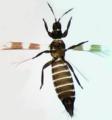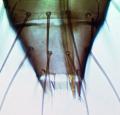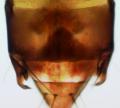Aeolothrips fasciatus
Recognition data
Distinguishing features
Both sexes with complete, banded wings; median pale band shorter than distal dark band. Body and legs brown, antennal segment III yellow with only extreme apex dark. Head and pronotum with no long setae. Fore tarsus apically with stout recurved ventral hamus. Antennae 9-segmented, segment III long and slender with linear sensorium scarcely 0.3 as long as segment, IV with sensorium almost 0.5 as long as segment and curved distally; segments V–IX forming a single unit with V about the same length as VI–IX. Abdominal tergite X with pair of very small trichobothria. Marginal setae on sternites arising at or close to margin; sternite VII supernumerary paired setae arising well in front of margin.
Male tergites IV and V sometimes with very small paired dorsal tubercles; setae at base of bifurcate claspers on tergite IX much longer than clasper, with no stout curved seta lateral to clasper; antennal segment III almost fuscous rather than yellow, but abdominal segments III–V sometimes paler than II and VI.
Related and similar species
The complex of species related to A. fasciatus, including some from California such as A. duvali, requires considerable further study. Just over 90 species are placed currently in the genus Aeolothrips, of which more than 50 are from the Palaearctic Region (mainly Europe), and 28 from the Nearctic (mainly western USA). Only two species are recorded from the Neotropics; one from Panama is based on a single male and is probably not a member of this genus (Mound & Marullo, 1996), and A. fasciatipennis Blanchard although common in Chile is known only from females and is probably a synonym of A. fasciatus.
Taxonomic data
Current valid name
Aeolothrips fasciatus (Linnaeus)
Original name and synonyms
- Thrips fasciatus Linnaeus, 1758: 266
- Coleothrips trifasciatus Fitch, 1855: 386
- Aeolothrips atricornis Maltbaek, 1927: 14
- Aeolothrips justiciae Post, 1961: 137
Family placement
Aeolothripidae
Biological data
Life history
Flower-living, but probably a facultative predator with a mixed diet of pollen and the larvae of other thrips.
Host plants
Found in the flowers of a range of plants, with no recorded specificity.
Tospoviruses vectored
None
Crop damage
None
Distribution data
Area of origin
Europe
Distribution
Females identified as this species have been recorded widely around the world, but males have been studied only from Finland, Denmark, Slovakia, Azores, Hokkaido, New Zealand and Tasmania. Some of the published records that are based only on females are probably misidentifications of A. intermedius Bagnall, a common species in northern Europe that has a rather shorter third antennal segment. Moreover, some of the North American records are possibly misidentifications of the brown morph of A. auricestus. Currently, if males are not available, it is probably not possible to identify species confidently in this group. From both New Zealand and Tasmania (Australia) males and females have been studied that cannot be distinguished from European specimens of A. fasciatus. Females from Chile to which the name A. fasciatipennis has been applied cannot be distinguished from A. fasciatus females, but no males of this group have been seen from South America.









